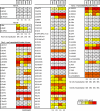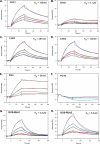Analysis of a clonal lineage of HIV-1 envelope V2/V3 conformational epitope-specific broadly neutralizing antibodies and their inferred unmutated common ancestors
- PMID: 21795340
- PMCID: PMC3196428
- DOI: 10.1128/JVI.05045-11
Analysis of a clonal lineage of HIV-1 envelope V2/V3 conformational epitope-specific broadly neutralizing antibodies and their inferred unmutated common ancestors
Abstract
V2/V3 conformational epitope antibodies that broadly neutralize HIV-1 (PG9 and PG16) have been recently described. Since an elicitation of previously known broadly neutralizing antibodies has proven elusive, the induction of antibodies with such specificity is an important goal for HIV-1 vaccine development. A critical question is which immunogens and vaccine formulations might be used to trigger and drive the development of memory B cell precursors with V2/V3 conformational epitope specificity. In this paper we identified a clonal lineage of four V2/V3 conformational epitope broadly neutralizing antibodies (CH01 to CH04) from an African HIV-1-infected broad neutralizer and inferred their common reverted unmutated ancestor (RUA) antibodies. While conformational epitope antibodies rarely bind recombinant Env monomers, a screen of 32 recombinant envelopes for binding to the CH01 to CH04 antibodies showed monoclonal antibody (MAb) binding to the E.A244 gp120 Env and to chronic Env AE.CM243; MAbs CH01 and CH02 also bound to transmitted/founder Env B.9021. CH01 to CH04 neutralized 38% to 49% of a panel of 91 HIV-1 tier 2 pseudoviruses, while the RUAs neutralized only 16% of HIV-1 isolates. Although the reverted unmutated ancestors showed restricted neutralizing activity, they retained the ability to bind to the E.A244 gp120 HIV-1 envelope with an affinity predicted to trigger B cell development. Thus, E.A244, B.9021, and AE.CM243 Envs are three potential immunogen candidates for studies aimed at defining strategies to induce V2/V3 conformational epitope-specific antibodies.
Figures




References
-
- Bryant D., Galtier N., Poursat M. A. 2007. Likelihood calculation in molecular phylogenetics, p. 33–62 In Gascual O. (ed.), Mathematics of evolution and phylogeny. Oxford University Press, Oxford, United Kingdom
-
- Burton D. R., et al. 1994. Efficient neutralization of primary isolates of HIV-1 by a recombinant human monoclonal antibody. Science 266:1024–1027 - PubMed
-
- Collins A. M., et al. 2004. Partitioning of rearranged Ig genes by mutation analysis demonstrates D-D fusion and V gene replacement in the expressed human repertoire. J. Immunol. 172:340–348 - PubMed
Publication types
MeSH terms
Substances
Grants and funding
LinkOut - more resources
Full Text Sources
Other Literature Sources

